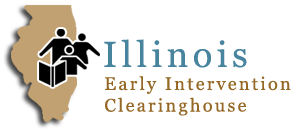Supporting Dual Language Learners in Early Childhood
This topical guide will introduce you to important books, videos, and information resources available from the EI Clearinghouse and other sources. Contact us via online form or by phone (1-877-275-3227) to request a resource listed below (or ask your local public librarian). Note that some videos may be viewed online, and journal titles will take you to the publisher’s homepage.
Table of Contents

EIC Resources
Books
This book shows teachers how to develop a toolbox of strategies for effectively teaching and engaging dual language learners while also supporting their families from diverse backgrounds.
This book is a resource for parents raising their child bilingually. Steiner and Hayes expose common myths about bilingualism, explain how the brain learns multiple languages, answer some frequently asked questions, and provide the reader with a variety of resources to help them along their journey of raising a bilingual child.
This book helps teachers understand the culturally and linguistically diverse children in their classroom, as well as those with disabilities.
This book is written for professionals working with early childhood students who are bilingual or learning a second language. It may help speech-language pathologists and educators determine whether language is typically developing or if there is a delay as they work with children and their families.
This handbook will help teachers meet individual needs and develop the confidence of young children with English as an additional language in their classrooms. There also are practical and varied language teaching strategies for promoting learning for children working individually or in small groups.
A collection of journal articles addressing the issues of early childhood and the development of language and literacy. Provides a good understanding how language evolves from infancy through toddlerhood.
Written with early childhood professionals and staff in mind, each chapter addresses a common question that may arise in a dual-language early childhood classroom. With a wide range of topics from assisting families in crisis who do not speak much English to addressing the needs of bilingual infants and toddlers with special needs.
The articles in this collection emphasize supporting children’s home languages, partnering with families to further children’s language learning, and adjusting practice to meet the needs of diverse learners.
This book offers teachers context, practical advice, and strategies to help young dual language learners thrive.
This book is a resource for anyone interested in the state of bilingual education in the United States. García takes a look at effective curriculum and instructional approaches used with English language learners in the American school system.
This concise book compiles everything teachers need to know about working with young DLLs – and setting them up for a lifetime of school success.
The articles in this monograph are focused on contemporary assessment practices with particular attention paid to gathering information about young children’s development in authentic and familiar settings such.
- Improving child find through tailored outreach to primary referral sources / Carl J. Dunst, Carol M. Trivette, & Glinda Hill
- Developmental screening in early childhood : potential roadmaps for those considering the journey / Jantine Clifford
- Assessment of family-identified needs through the routines-based interview / R.A. McWilliam
- Using the assessment of family activities and routines to develop embedded programming / Philippa H. Campbell
- Using your good judgment : informed opinion for early intervention / John T. Neisworth & Stephen J. Bagnato
- Using digital video to enhance authentic assessment / Larry Edelman
- Bringing pieces together : assessment of young children’s social-emotional competence / Rosa Milagros Santos
- Evaluating young children who are dual language learners : gathering and interpreting multiple sources of data to make informed decisions / Lillian K Durán, Gregory A. Cheatham, & Rosa Milagros Santos
- Using goal attainment scaling to monitor the developmental progress of young children with disabilities / Laurie A. Dinnebeil, Margie Spino, & William F. McInerney
- Building good assessment into accountability systems for early childhood programs / Kathleen Hebbeler
- Resources within reason : assessment / Camille Catlett.
Videos and Media
This DVD/guide combination provides vital information about normal second language acquisition processes as well as a discussion of the phenomena of bilingualism as a foundation for distinguishing between language differences and disabilities in English language learner (ELL) students. Assessment considerations and techniques used to differentiate between language difference and disability in ELL students are highlighted.
María Adelaida Restrepo, associate professor in the Department of Speech and Hearing Science at Arizona State University, is a bilingual speech-language pathologist. In this instructional film, she outlines intervention principles and other factors to consider when planning intervention programs for English language learners (ELLs). Specific areas of language intervention for ELL children with language disorders are discussed. Preventive techniques for their general language needs in the classroom and at home also are addressed.
This video discusses techniques for educating young children who are dual-language learners as well as demonstrating recommended methods of assessment. This DVD was created as a companion to the book One Child, Two Languages by Patton O. Tabors. It includes educating and assessing young second-language learners.
Embracing a child’s first language at home and in the classroom is the foundation for successful acquisition of any second language. Becoming bilingual or multilingual is a necessity for some children and a privilege for all. This video inspires a positive philosophy and provides where-to-begin guidelines as well as hands-on activities to create the environment that is absolutely necessary for strong development of a second language in young children.
This video covers the support of English as a second language (ESL) learners in early childhood programs. Integral to this program is the importance of the support of families and the integration of community resources.
Organizations
ASHA is a professional association for speech-language pathologists and audiologists. This site contains numerous resources, including topic-specific guides, continuing education opportunities, ASHA publications, articles, an online store, and the latest research. ASHA Special Interest Groups were created to promote specific professional interests among members, develop communication and networking in diverse professional settings, identify and convey concerns and needs to the Association’s governance, and assist in policy formation.
This is a bilingual site for educators and families of English language learners.
Articles
This study was designed to test the hypothesis that native language instruction enhances English language learner’s (ELL’s) native language and literacy development without delaying English development. Results showed that Spanish language instruction increased Spanish oral vocabulary and letter-word identification without significant differences between bilingual and English-only classrooms on these same measures in English.
The article discusses strategies for helping infants and toddlers from diverse language and cultural backgrounds adjust to early childhood care situations, focusing on practices that support children’s home languages and help develop English language skills.
The author stresses the important role of early childhood educators in helping young dual language learners retain their home language while building their English language skills. She suggests strategies to improve a preschool program’s effectiveness in teaching dual language learners.
This study used multiple years of data from an Even Start program and relevant comparison groups to consider bilingual education in preschool. The study provides some evidence of the effectiveness of bilingual education in preschool, but further research is needed to validate the findings.
Web Resources
This blog is intended to help parents and teachers support these children as they learn English and their home languages. A recent trend in early childhood and education in Illinois is the increasing population of children who speak a home language other than English and enter early care and education with few or no English words.
An Illinois Early Learning Project tipsheet for parents and caregivers. Children who know more than one language often benefit in school and later in life. Also, many parents and grandparents find that talking to older children about important life matters is easier if the children retain their home language skills. Also available in Polish, Chinese, Arabic, and French.
Author Linda Halgunseth writes a family-friendly article about how children have the ability to learn multiple languages. She explains the stages children go through when they learn a new language, describes the benefits of knowing more than one language, and suggests tips and ideas for parents to incorporate with their child to foster multi-language learning.
This site offers information on curriculum, learning environments, brain development and screening, assessment, evaluation and observation of infants and toddlers.
The National Clearinghouse for English Language Acquisition “supports the U.S Department of Education’s Office of English Language Acquisition, Language Enhancement, and Academic Achievement for Limited English Proficient Students (OELA) in its mission to respond to Title III educational needs and implement NCLB as it applies to English language learners.” The NCELA Web site includes state and district statistics on English language learners and a resource library with articles focused on topics such as early childhood and bilingual education.
This Web site defines dual language, lists types and features of dual language education programs, contrasts what is considered a dual language program with what is not, and mentions what the program looks like as children progress through school. Links to additional resources and other organizations’ Web sites are provided.
The POLL Program was created to strengthen teacher practices in working with young dual language learners and their families. The resources outline the training model that focuses on the value of and support for a child’s home language, getting to know the child and family, and concrete strategies early childhood educators can use to support linguistic growth. Piloted in a California community, with input from national experts, the full toolkit is now available.
This Web site provides links to information about English language learning (ELL) education, bilingual education, immigrant education, two-way immersion, sheltered instruction, and teacher education. The site also provides links to projects and resources pertaining to each of the topics.

